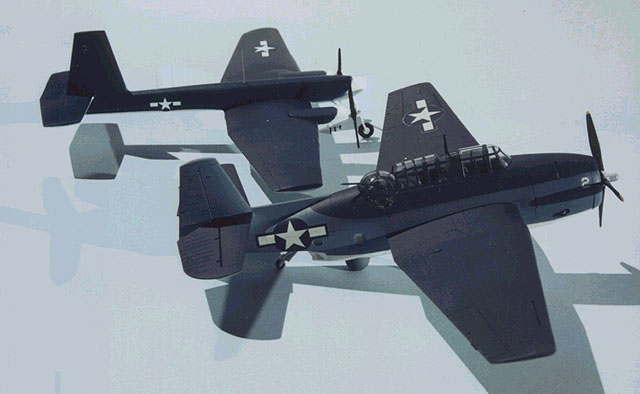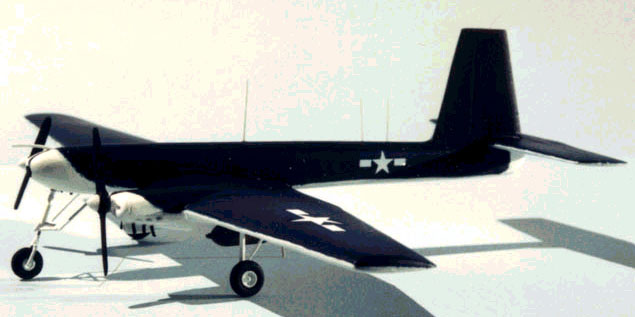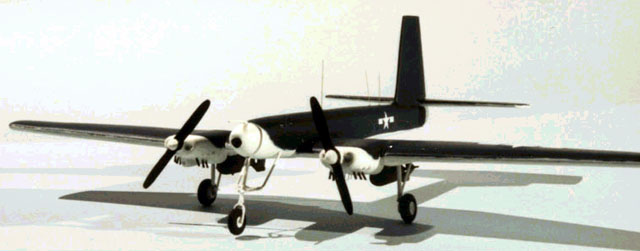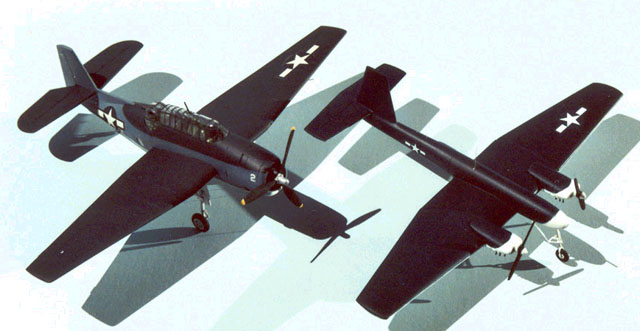|
TDR
Assault Drone
and
TBM
Avenger Control Aircraft
by
Thomas Conte
|

|
|
Interstate TDR Assault
Drone and
TBM Avenger Control Aircraft |

HyperScale is proudly sponsored by Squadron.com
Smart bombs and cruise missiles of the present day can trace their
ancestry back to World War Two and even earlier.
The Interstate TDR assault drone was the result of testing done by the
U.S. Navy during the late thirties. At this time a group of officers began
experiments with radio control aircraft for the use as a target for
practice by the fleet. These test evolved into an aircraft that could be
remotely controlled to attack a ship or other type of targets. The world
's first guided missile attack was accomplished on September 14th, 1938
against the USS Utah using a N2C-2 drone. It is interesting to note that
this was completed a full two years earlier than the German's projects
which used an unpowered gliding bomb. The N2C-2 was a converted Navy
biplane trainer.

Following this success, plans were considered to convert obsolete
aircraft into target and assault drones. The outbreak of WW II changed
this and now a requirement for a specially built aircraft was created. Two
aircraft came out of this specification - the Interstate's TDR and the
Naval Aircraft Factory's TDN. Both aircraft were designed to accept a
number of low power piston engines and roughly the same dimensions; a 50
ft. wingspan and about 36 ft. long. The TDN differed from the TDR by
having a shoulder mounted wing. Both were made from subcontracted parts so
there could be a number of manufactures that can claim having a hand in
their construction. Each aircraft could be flown by a pilot onboard during
testing, ferrying, or when checking out newly installed hardware.
As crude as these aircraft appeared, they were packed with the latest
hardware of their time. They had the capability to hold a heading, fly a
set pattern, and maintain a specific altitude besides being controlled by
a ground or airborne transmitter from a good distance. They also carried a
television transmitter whose images were sent to the controlling aircraft.
The drone controller pilot onboard the Avenger used the TV images to
acquire the target and fly the drone into it. With all of this equipment
the drone could takeoff with up to 2000 lbs. of explosives and either drop
it or be flown directly into the target.

During the War in the Pacific nearly four dozen of these aircraft,
mostly the TDR was used against the Japanese during 1944 in the Rabaul
area. They were used by a Special Task Air Group One, Special Air Task
Force (STAG ONE SATFOR).
Much more information can be found on their website, http://www.stagone.org
or in the book by James J. Hall American Kamikaze.
The model came about because references to this type of aircraft kept
coming up during my research into similar type used by the other
combatants during WW II.
Finally I learned that one was, at the time, on display at the U.S.
Naval Museum at Pensacola, Florida, US. I made the trip to take photos and
to find more leads. From more detective work I was able to come into
contact with a Mr. Newton who was involved with them during the war and
who kindly provided me with more details. With this information I later
discovered from old magazines from the 40's, I created a set of working
drawings to make a master model in 1/72 scale so that I could make a
number of resin cast models.

Remember I mentioned that these aircraft were designed to be powered by
a number of different engines and to be piloted? Well I was planning to
build a number of models to represent the variants and that meant that if
I did not want to build each one separately, I had to make a master and
molds to create my fleet of assault drones. The one in the photo is the
first out of the molds.
The model was assembled from parts taken from molds made from RTV and
the master and then using available urethane cold casting resin for the
production of the final pieces. After removal from the molds the parts
were cleaned with alcohol and super glued together. After everything was
checked it was given a coat of primer and airbrushed with Testor's paint
and given a flat final coat. The landing gear is made from small brass and
aluminum tubing that was also super glued into place.
Since the major difference between the TDR type were their engines, the
center section of the wing master was made with no fairings for any type
of engine. The first model, the one in the photos, shows a TDR with two
horizontally opposed engines, no pilot, and carryings two 1000 lbs. bomb
under the wing racks. The next project will a version with two radial
engines and piloted. The model has a wingspan of 8.33 inches and is 6
inches long.
While it is not hard to create a model like this, it takes time to
describe how to do it. If there are a number of people who are interested,
when I build the next TDR I will photograph the steps and write a more
detail description. If you let Brett or myself know I would be glad to put
something together.

The Grumman TBM drone controller aircraft was built to give a sense of
size to the TDR. It started out as a Hasagawa TBF Avenger model since my
information indicated that the first batch of Grumman aircraft built by
General Motors (the M in TBM ) were identical to the ones built by Grumman
(the F in TBF ). The major external change was the addition on the
retractable radar dome on the bottom of the fuselage behind the bomb bay
doors. In the photo, it is extended more than it should while the aircraft
was on the ground, this was done in the photo to make it more noticeable.
The other modification was in the cockpit area behind the pilot seat. An
additional seat and instruments were added in the position the drone
control pilot occupied, which was behind the original pilot's seat. The
rest of the model was completed normally and finished in Testor's solvent
base paints.
The models make a very interesting addition to my collection of WW II
aircraft and are something different from what's being offered by the
model manufactures.
Model, Text and Images Copyright ©
2001 by Thomas Conte
Page Created 13 July, 2001
Last Updated 04 June, 2007
Back to HyperScale
Main Page
Back to Features Index
|
Home
| What's New |
Features |
Gallery |
Reviews |
Reference |
Forum |
Search